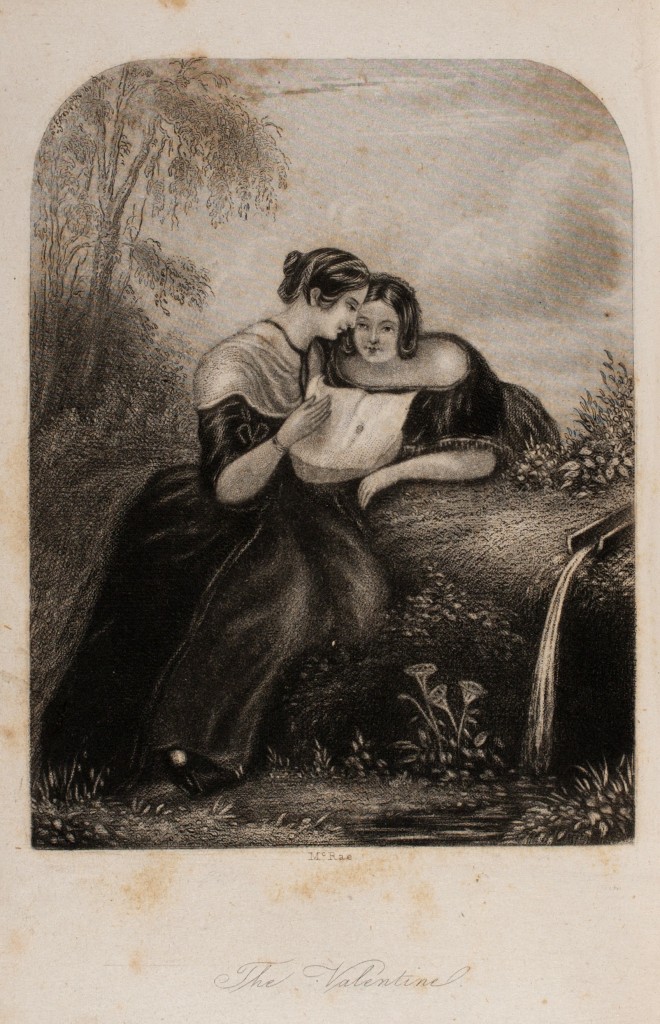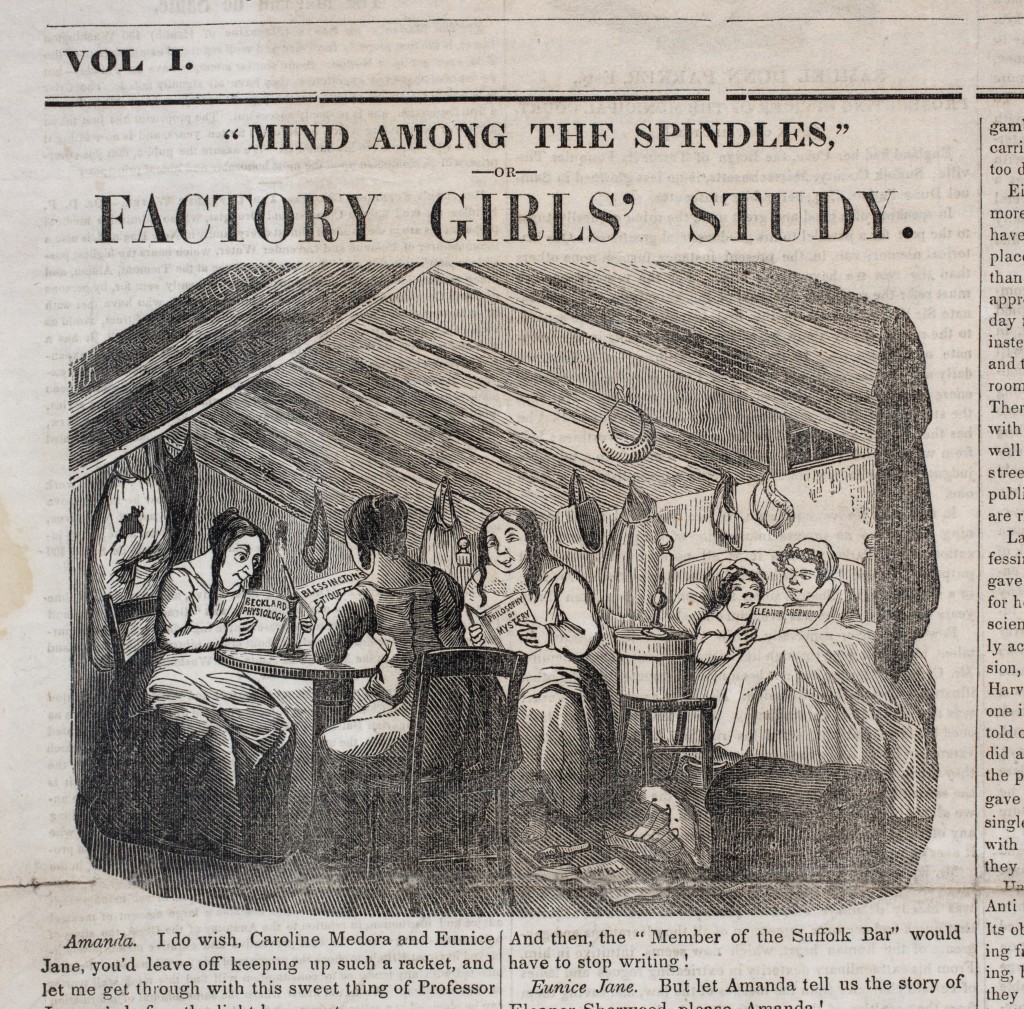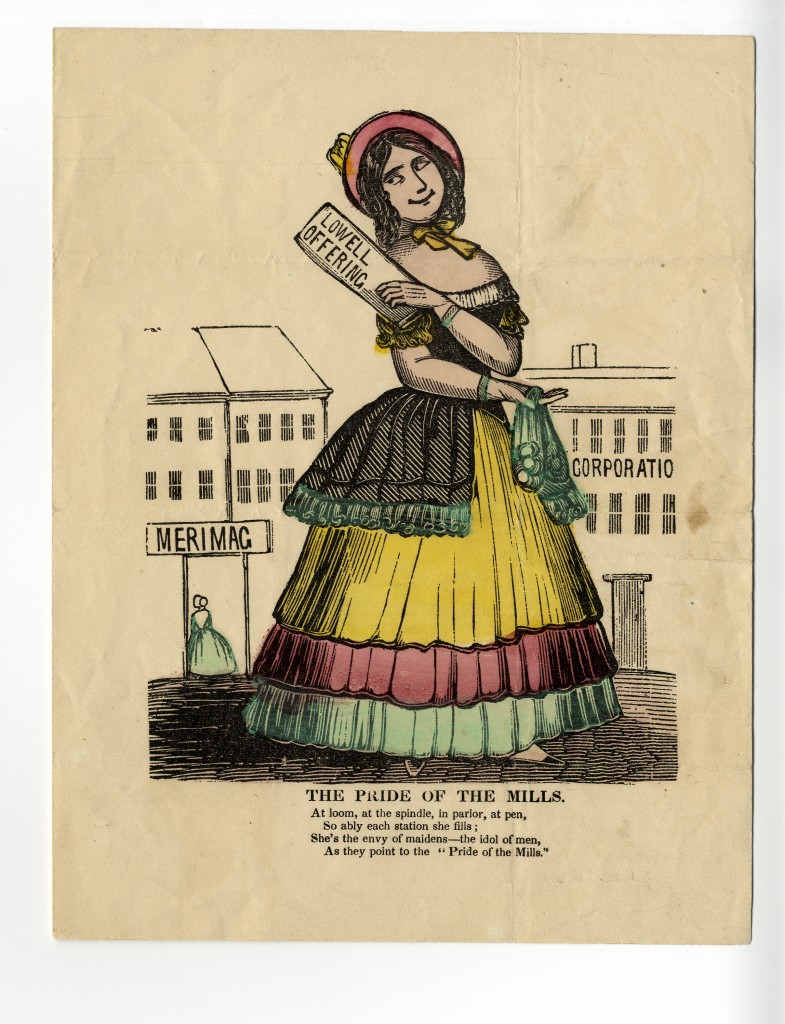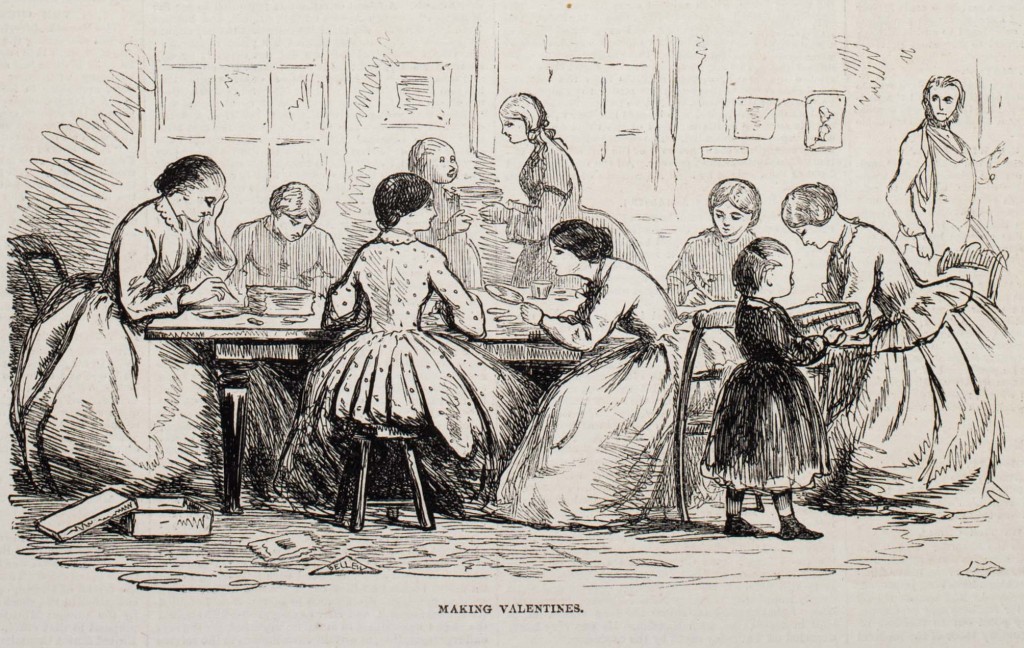 As has been blogged on Past is Present before, AAS has an extensive and representative assortment of nineteenth- and early-twentieth-century valentines. Part of the Graphic Arts Collection, these ephemeral pieces of affection were exchanged on or before February 14, as Valentine’s Day provided the perfect opportunity to give that special someone a card. Many were sentimental; sometimes they were comical.
As has been blogged on Past is Present before, AAS has an extensive and representative assortment of nineteenth- and early-twentieth-century valentines. Part of the Graphic Arts Collection, these ephemeral pieces of affection were exchanged on or before February 14, as Valentine’s Day provided the perfect opportunity to give that special someone a card. Many were sentimental; sometimes they were comical.
But Valentine’s Day culture appears in more than just valentines themselves. Gift books and annuals, for example, show the predictable scene of giving and receiving the greetings. “The Valentine,” a plate appearing in Temperance Offering circa 1853, was engraved by John C. McRae and shows two women outdoors sharing the opening and reading of a valentine.
Yet exterior views such as these seem to forget the reality of valentine making, manufacture, and mailing, a point not lost on several periodical writers in the nineteenth century. Instead of surveying the collection or showing some of the enchanting examples of romantic/sentimental valentines (which have been featured this week to our Instagram followers), this post will examine a particular valentine found within the collection and look at it from a few angles.
The valentine “Pride of the Mills” (below) is housed in the comic valentine category. It features a caricature of a well-dressed woman worker in the Merrimack Mills in Lowell. In one hand she holds a rolled copy of the Lowell Offering, in the other bags of coins. The poem beneath reads, “At loom, at the spindle, in parlor, at pen,/So ably each station she fills;/She’s the envy of maidens-the idol of men,/As they point to the ‘Pride of the Mills.’”
Though the mill girl is the subject of this comic valentine, and perhaps not its intended recipient, part of its ironic interest is that the Pride is outside the mill. Indeed, the image and text show a deceptively independent woman (as opposed to other comical valentines, which range from the crude or rude to exaggerated features and professions). Comparatively, this one is tame. And yet it is one laced with confusion. The Pride of the Mills is an advocate for change, yes. Women, for any number of reasons, have to work in a factory to earn money and yet, re: valentines, are to maintain a passive role in the game of love.
The Lowell Offering—written, edited, and published by female operatives employed in the mills—instigated a conversational line about the sending of Valentines.
In the March 1, 1845, issue of the periodical, “Q” states:
There have been several thousand Valentines distributed from the Lowell post-office this month. We are acquainted with one lady who wrote a letter to a stranger, last Valentine’s day, who is this year upon the eve of marriage with him. Girls! Is this an argument in their favor or not?
Like many articles in the Lowell Offering, this piece invites the readership into dialogue. Much in the same way the comic valentine does.
 The discussion about factory girls is never uncomplicated, as this illustration of “‘Mind Among the Spindles,’ or Factory Girls’ Study” in the April 1846 Boston City Crier and Country Advertiser makes clear. In the image, young women sit gathered around a table or curled up in bed together reading; a discarded copy of the Lowell Offering is cast on the floor. The girls are reading copies of Eugène Becklard’s Physiological Mysteries and Revelations in Love, Courtship and Marriage, a guidebook on marriage, sex, and hygiene (AAS has several copies of the text in its collection). They are also reading J.H. Ingraham’s Eleanor Sherwood (Ingraham also wrote The Beautiful Temptress), Lady Blessington’s “Etiquette,” and The Philosophy of Mystery by Walter Cooper Dendy. The illustration and selected texts suggest the less than ideal reading habits among the factory’s spinning machines and that little else is on the mind of these women but the vagaries of love and the human experience.
The discussion about factory girls is never uncomplicated, as this illustration of “‘Mind Among the Spindles,’ or Factory Girls’ Study” in the April 1846 Boston City Crier and Country Advertiser makes clear. In the image, young women sit gathered around a table or curled up in bed together reading; a discarded copy of the Lowell Offering is cast on the floor. The girls are reading copies of Eugène Becklard’s Physiological Mysteries and Revelations in Love, Courtship and Marriage, a guidebook on marriage, sex, and hygiene (AAS has several copies of the text in its collection). They are also reading J.H. Ingraham’s Eleanor Sherwood (Ingraham also wrote The Beautiful Temptress), Lady Blessington’s “Etiquette,” and The Philosophy of Mystery by Walter Cooper Dendy. The illustration and selected texts suggest the less than ideal reading habits among the factory’s spinning machines and that little else is on the mind of these women but the vagaries of love and the human experience.
Though factory work and valentines seem an unlikely alliance to make, we can momentarily look at Worcester-born Esther Howland (1828-1904) who, when her amorous art skyrocketed in popularity, employed the assembly-line system to create her valentines. While Howland remains one of Worcester’s success stories, the industrial-made cards were not without their critics.
Godey’s Lady’s Book lamented in its February 1849 issue that “the title [Valentine] is bestowed on printed doggerel, bought in market and distributed through penny-post, with no more of sentiment to consecrate the offering than though these were patented recipes for colds, or notices of a new milliner’s shop.” The reproduction of sentimental cards, according to the Lady’s Book, was mournfully sublet to the factory setting rather than lovers creating their own homemade (or at least less generic) sentiments.
Similarly, an article called “A Valentine Factory” in the January 1874 American Artisan and Illustrated Journal of Popular Science echoes the same general attitude. Noting the disconnect between the delicate sentiments contained within a Valentine and the reality of how they are created, the author of the article notes, “Brawney-armed mechanics are turning out a strange medley of lovers and bowers, flowers, birds hearts and arrows, bachelors and pining spinsters.”
A Harper’s Weekly engraved illustration by Frank Bellew (above) shows an interior where women are at work creating valentines.[1] Harper’s, with its general-audience appeal, even comments on the manufacturing process of valentines: “Few guess the amount of capital invested in the manufacture of these missives – amatory and otherwise – or the vast number sold and dispatched each year.” (The article, from February 13, 1858, is reproduced here and here). The article continues with regards to the employment behind these valentines, “seventy-five are women and twenty-five boys and men” – or to the point, it was another employment opportunity for women.
If you are looking for valentines, the Antiquarian Society is undoubtedly a unique resource of study. And if you’re looking for periodical writers and editors (such as Harper’s, the American Artisan, Godey’s, and even to an extent the Lowell Offering) to critique and admit the disconnect of making these items commercially, we are fertile ground as well – love knows no bounds!
[1] See additional images in AAS Online Exhibition A Woman’s Work is Never Done.


